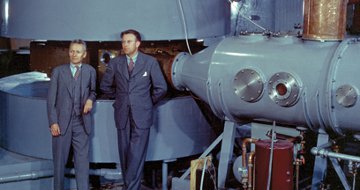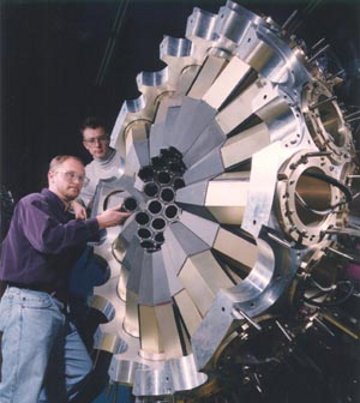The chemical element lawrencium is classed as an actinide metal. It was discovered in 1961 by Albert Ghiorso, Torbjørn Sikkeland, Almon Larsh and Robert Latimer.

Data Zone
| Classification: | Lawrencium is an actinide metal |
| Color: | |
| Atomic weight: | (262), no stable isotopes |
| State: | solid (presumed) |
| Melting point: | |
| Boiling point: | |
| Electrons: | 103 |
| Protons: | 103 |
| Neutrons in most abundant isotope: | 159 |
| Electron shells: | 2,8,18,32,32,9,2 |
| Electron configuration: | [Rn] 5f14 6d1 7s2 |
| Density @ 20oC: |
Reactions, Compounds, Radii, Conductivities
| Atomic volume: | – |
| Structure: | – |
| Hardness: | – |
| Specific heat capacity | – |
| Heat of fusion | – |
| Heat of atomization | – |
| Heat of vaporization | – |
| 1st ionization energy | 470 kJ mol-1 |
| 2nd ionization energy | – |
| 3rd ionization energy | – |
| Electron affinity | – |
| Minimum oxidation number | 0 |
| Min. common oxidation no. | 0 |
| Maximum oxidation number | 3 |
| Max. common oxidation no. | 3 |
| Electronegativity (Pauling Scale) | – |
| Polarizability volume | – |
| Reaction with air | |
| Reaction with 15 M HNO3 | |
| Reaction with 6 M HCl | |
| Reaction with 6 M NaOH | |
| Oxide(s) | |
| Hydride(s) | – |
| Chloride(s) | |
| Atomic radius | – |
| Ionic radius (1+ ion) | – |
| Ionic radius (2+ ion) | 88.6 pm |
| Ionic radius (3+ ion) | – |
| Ionic radius (1- ion) | – |
| Ionic radius (2- ion) | – |
| Ionic radius (3- ion) | – |
| Thermal conductivity | – |
| Electrical conductivity | – |
| Freezing/Melting point: | – |

Lawrencium was named after Ernest Lawrence (right). Lawrence won the Nobel prize for inventing the cyclotron particle accelerator, used to discover a number of synthetic elements. Image Ref.(3)
Discovery of Lawrencium
Lawrencium was synthesized in 1961 by Albert Ghiorso, Torbjørn Sikkeland, Almon Larsh and Robert Latimer at the Lawrence Berkeley National Laboratory, California.
It was the last member of the actinide series to be discovered.
A heavy-ion linear accelerator (HILAC) was used to bombard a 3 milligram target of californium (consisting of a mixture of californium isotopes of mass number 249, 250, 251, and 252) with boron-10 and boron-11 ions, producing lawrencium. (1), (2)
The target consisted of a mixture of californium isotopes and therefore an exact mass of the new element could not be assigned. Later research suggested that lawrencium-258 (half-life 4.2 seconds) was produced in the 1961 experiment. (2)
The element was named after Ernest Lawrence, inventor of the cyclotron particle accelerator.
The symbol Lw was used originally, but in 1963 this was changed by The International Union of Pure and Applied Chemistry (IUPAC) to Lr.
Appearance and Characteristics
Harmful effects:
Lawrencium is harmful due to its radioactivity.
Characteristics:
Lawrencium is a synthetic, highly radioactive metal that has only been produced in miniscule amounts.
Lawrencium is a trivalent ion in aqueous solution. (2)
Lawrencium metal has not been prepared. (2)
All of its isotopes are short-lived. Its longest lived isotopes is 262Lr with a half-life of 216 minutes.
Uses of Lawrencium
Lawrencium is of scientific research interest only.
Abundance and Isotopes
Abundance earth’s crust: nil
Abundance solar system: –
Cost, pure: $ per g
Cost, bulk: per 100g
Source: Lawrencium is a synthetic element and is not found naturally. Lawrencium is created by nuclear bombardment, and has only been produced in miniscule amounts.
Lawrencium-256 can be produced by the irradiation of a californium-249 target with boron-11 ions.
Lawrencium-260 can be produced by the irradiation of a berkelium-249 target with oxygen-18 ions. (2)
Isotopes: Lawrencium has 10 isotopes whose half-lives are known, with mass numbers 253 to 262. Lawrencium has no naturally occurring isotopes.
Its longest lived isotopes are lawrencium-262 with a half-life of 216 minutes, lawrencium-261, with a half-life of 39 minutes and lawrencium-260 with a half-life of 180 seconds.

References
- John Emsley, Nature’s building blocks: an A-Z guide to the elements., Oxford University Press, 2003., p460.
- Robert J. Silva, The Chemistry of the Actinide and Transactinide Elements., Springer., Vol 3.13, p1641-p1645.
- Image LBL.
Cite this Page
For online linking, please copy and paste one of the following:
<a href="https://www.chemicool.com/elements/lawrencium.html">Lawrenciumm</a>
or
<a href="https://www.chemicool.com/elements/lawrencium.html">Lawrenciumm Element Facts</a>
To cite this page in an academic document, please use the following MLA compliant citation:
"Lawrenciumm." Chemicool Periodic Table. Chemicool.com. 07 Oct. 2012. Web. <https://www.chemicool.com/elements/lawrencium.html>.

it helped so much thank you =D
Writing report on all man-made elements. Amazing to see all we have made over the years.